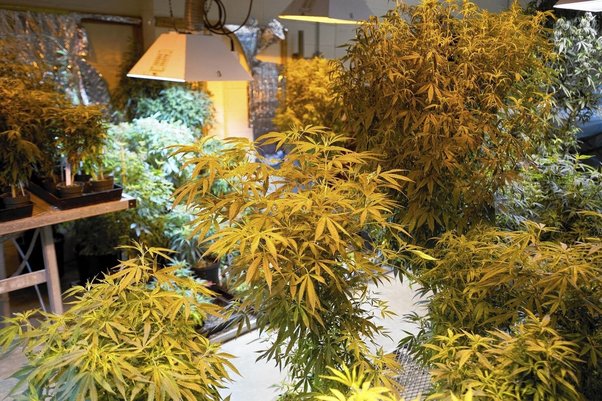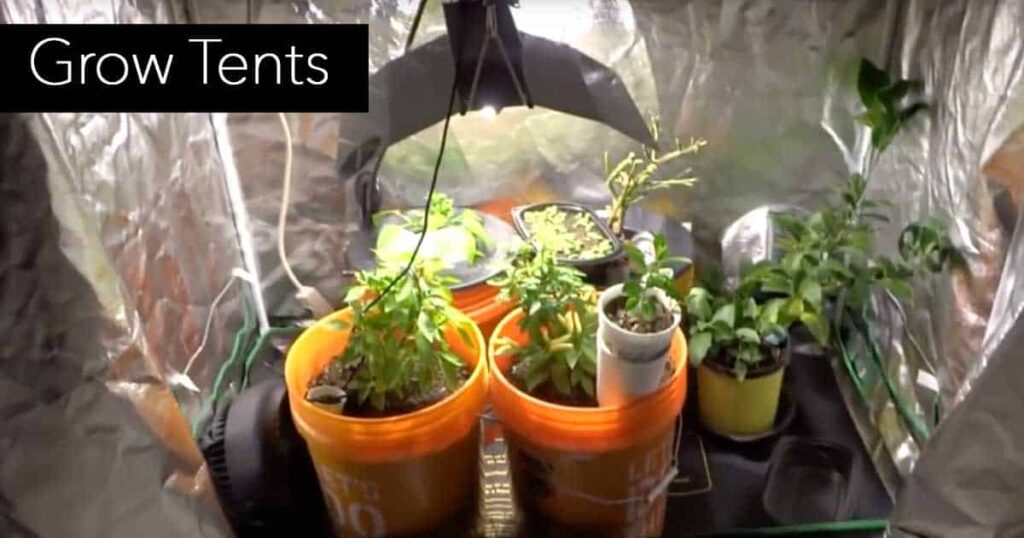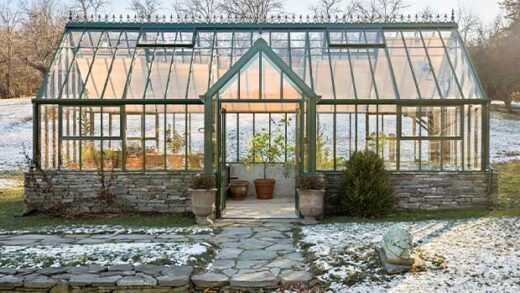Are you planning to start growing indoors? When planning an indoor growing setup, one thing to take for granted is the number of plants you can grow indoors. Some growers make the mistake of underutilizing their grow shed real estate when they could have more plants because more plants mean a bigger harvest. So, how many plants can be grown in the most common tent sizes? The problem with having too many plants in a grow tent is that it really depends on the size of your grow tent, what kind of containers or plant pots you have, and the kinds of plants you’re growing.
Table of Contents
Why You Should Not Crowd Your Tent

I’ve established the principle of not overcrowding your tent here, but I still want to stress why this is so important.
Here I have categorized the different ways plants are affected because there are too many plants in a single grow tent.
Growth nutrients
The main reason is that it really affects the growth of the plant. If you’re just starting from seed, it may not even germinate.
It’s still possible for some plants to grow in overcrowded growing areas, but you’ll most likely not be happy with the results. Especially when you are growing crops.
Your plants need enough light, air, water, and soil nutrients to grow healthily, and that won’t happen if you keep them in an overcrowded area.
Think of it this way: instead of focusing on how to stay healthy, they’re focusing on getting enough light, air, etc., because they’re housed in a crowded area.
Even if you use the best fertilizers to help your plants or crops grow the way you want, your plants still won’t grow optimally without enough space.
Flowering
Speaking of your plants not growing at their best, as mentioned earlier, some plants may still be growing in crowded growing spaces. However, this may still not be a successful growth.
If you’re growing a leafy crop, the plant’s leaves may become floppy and tough. For crops to grow, it is possible that they may be too small. The simplest solution is that you will only be disappointed with the results.
Pests
Beyond that, overcrowded planting spaces are more likely to be infested without you noticing. Poor air circulation can easily lead to fungal diseases such as mold or mildew in plants.
Proper spacing helps air circulation. Using a dehumidifier won’t really save your plants unless you space them properly.
The worst thing that can happen is that by the time you notice, all of your plants are powerless. Don’t overcrowd your growing area, this will definitely help you out.
Determining The Best Number Of Plants For Grow Tent

Legal Restrictions On Growth Setup
Laws on home and business development are being loosened across the country. However, most states still impose restrictions on cultivation.
For example, California law allows home growers to grow up to six plants for recreation. As far as medicinal marijuana is concerned, you can freely grow it within 100 feet of your residence.
In Alaska, each adult over the age of 21 can have up to six plants. However, only three of these plants can bloom at the same time.
The constraints set by business growth can be more complicated.
So, before you decide how many plants to grow, see what the local laws say. Then start with that number.
Size of the Grow Room or Tent
Next, consider measurements for your grow room, grow tent, or grow facility. Determine how many plants you can reasonably grow without overcrowding.
A general rule of thumb is to allow one square foot per plant. This is a minimum unless you use the green ocean method. Allow extra space if you want your plants to grow larger than this. Notice how much space there is above the light. Most plants double in height once they bloom. This may be related to many indica lines and many Sativa lines. You don’t want your plants growing under lights where they will get burnt by the light.
Efforts You Put In
If your goal is professional growth, you may be able to skip this step. If you want to make a profit, hard work is inevitable.
On the other hand, if you’re creating a home-growing setup, your interest in the hobby should come into play.
The more plants you have, the more time you can spend each day transplanting, monitoring, and caring for your plants. If your space is really crowded, you may find the work more frustrating because it’s hard to reach the plants behind.
However, if you wish to enjoy the time you spend farming, growing a larger crop may be a more beneficial option. It really depends on how much you want to invest in this.
Harvest Goals and Priorities
The number of plants you grow affects not only the cultivation process but also the results. Here are a few useful questions to ask yourself:
- Am I thirsty for harvest?
The larger the plant, the longer the growth cycle. This is because those smaller plants need extra time to grow, develop and fill the available space in the vegetable.
If you want to go vegan and bloom faster, you should plant more and smaller plants.
- Do I want higher yields?
If high yields are a priority, plant as many as possible. Between a higher number of shoots and a faster harvest, the high-capacity growth pattern pays off more and faster. You can also get more of your annual harvest by shortening your vegetarian diet.
This especially feels like a win when you consider the resources invested in it. Your return on investment is higher in terms of equipment cost, energy consumption, and time.
- Do I want variety?
If you want to experiment with different varieties, you have to grow more plants.
However, it should be noted that different strains tend to have different needs in terms of nutrients, irrigation, and light intensity. Therefore, crop diversification requires additional work and attention.
Capabilities of the Lights
Do you know the footprint of your growth? This should be the primary consideration. If you grow plants with more light mulch than you have, you will have a disappointing harvest.
For example, your grow setup is a tent with a single LED light that covers an area of 3 feet x 3 feet. You can’t grow more than nine average-sized plants in that space in that light. Even if you see light falling outside these peripheries, it’s not high-quality light.
Spreading light evenly throughout the canopy is critical for best results. In fact, lighting is often one of the most important considerations when achieving high-quality indoor growth.
If you haven’t already chosen a lighting system for your grow setup, letting the number of plants you want help you narrow down your lighting options.
When researching grow lights, also consider the future of your grow setup. Even if you just want to start with a few plants to get a feel for the process, you may want to expand your planting later. Choose a light that will give you room to grow.
Pots Or Containers
When you get the right pot or growing container, you definitely have plenty of options.
If you’re growing small plants that don’t require large pots or containers, such as plants that are 2 liters and above, then you can put some in the tent.
Here, what you really want to avoid is overcrowding your tent and suffocating your plants. In a 4×4 tent, you can hold up to 15 plants in the grow bag.
If you have containers, you can fit 10 5-gallon jars. If you own a reservoir, the situation is different. You can only have one in the tent, but hey, a reservoir can hold some plants, so it’s not that bad.
If you have a hydroponic system, it will most likely require more space than traditionally grown plants because it requires a pumping system. So be mindful of how many containers you want to hold.
In addition to size, the shape of the container also needs attention. You have many options from round to octagonal pots or containers, so keep that in mind when estimating how many plants you can fit in your grow tent.
I strongly recommend that you place at least 2 inches between containers to avoid choking the plants. If you plan to grow your plants very large, then you can give each grow container a larger space.
Your Crops Or Plants
Before you start indoor gardening, you probably already have plants or crops you want to grow.
This is probably the first thing you think about rather than your room to grow, but if you have limited space, sometimes you end up choosing the growth area that you think is best for you.
The size of your grow tent still matters here, but the type of plants you grow will also determine whether you have too many plants in your tent.
Always consider how the plant will grow. If your plants end up with broad leaves, be sure to give them plenty of room.
Some plants tend to grow tall, so don’t use a fence that helps maximize space. This will not promote the growth of tall plants.
Final Thoughts
The main answer to how many plants are too many in a grow tent is that it really depends on several factors already listed above.
Beyond that, your assessment does play a vital role in ensuring that your plants are in the light, nutrients, water/humidity environment they need for healthy growth.
I want to stress that quality is more important than quantity. If you want to enjoy gardening and achieve satisfactory results, it is important to ensure that you only have enough crops or plants in the allotted space.
Your goal should be to keep your plants thriving. Once you’ve determined the spacing and size of your grow tent, you can focus on the environment and other factors, such as testing quality and expanding your cultivation for a successful cannabis harvest.
Gardening should also be fun, not just stressing yourself out because you have too many plants in your tent!

















